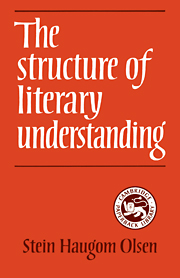Book contents
4 - THE STRUCTURE OF THE LITERARY RESPONSE
Published online by Cambridge University Press: 30 September 2009
Summary
Introduction
When an author produces a text which he claims to be a literary work, he commits himself to having certain aesthetic intentions. Conversely, when a reader interprets a text as a literary work he attributes to the author certain aesthetic intentions. Interpreting something as a literary work is to ascribe these intentions to the author. As an action the literary work is aimed at producing an aesthetic response, so that response is what the author necessarily intends to achieve in a reader. The nature of the aesthetic intention and the corresponding response which is its target are conventionally determined. A reader may choose whether or not to see a text as a literary work, but once the choice to see it as such is made, there is no choice as to what intentions he can attribute to the author. The literary work differs from other texts in its capacity to fill a certain role in a community of readers: a role defined by concepts and practices which the readers master. Those concepts and practices which define the role of the literary work in a community of readers must be the subject of analysis for the literary theorist.
A text is made up of sentences. A peculiar feature of the reader's attitude to the text which he considers a literary work is the refusal to see the text merely as sentences following each other and leading to the next. Instead there is an attempt to impose some sort of structure on the text, to divide it into parts and to interrelate the parts in a pattern. These parts may be called ‘segments’.
- Type
- Chapter
- Information
- The Structure of Literary Understanding , pp. 82 - 117Publisher: Cambridge University PressPrint publication year: 1978



